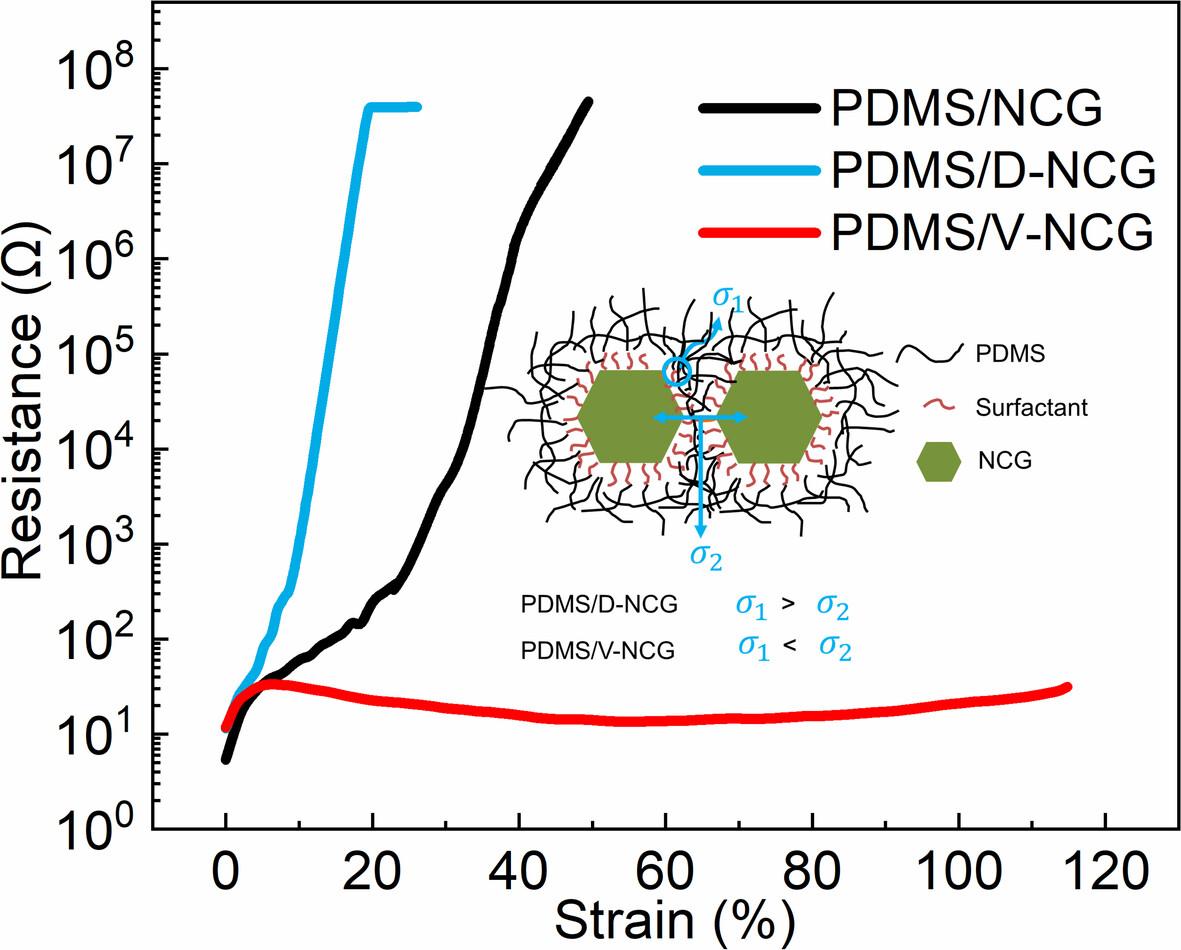Rong Zhang, Qian Liu, Yifan Xiang, Siqi Li, Wuhou Fan, Chengcheng Xu, Qingting Liu, Xudong Fu, Shengfei Hu
求助PDF
{"title":"通过调整界面效应,采用简便沉积法制备高拉伸性和导电性聚二甲基硅氧烷/镍涂层石墨复合材料","authors":"Rong Zhang, Qian Liu, Yifan Xiang, Siqi Li, Wuhou Fan, Chengcheng Xu, Qingting Liu, Xudong Fu, Shengfei Hu","doi":"10.1002/pi.6675","DOIUrl":null,"url":null,"abstract":"<p>Stretchable electrodes are essential parts for flexible electronics which are widely applied in human health monitoring, wearable electronics, robotics etc. Conductive elastomer composites are good candidates for stretchable electrodes; however, it is a challenge to maintain the resistance of conductive elastomer composites during elongation due to the departure of filler networks. In this work, highly stretchable and conductive polydimethylsiloxane (PDMS)/nickel-coated graphite (NCG) composites were fabricated based on the filler sedimentation method, in which NCG was modified by the coupling agent of the end alkyl group (dodecyltriethoxysilane, DTES) and end vinyl group (vinyltriethoxysilane, VTEO), considering the force between the filler networks and filler–matrix interface. The DTES modified NCG mainly improved the filler–matrix interface, which made the resistance of the composites clearly increase with strain, while the VTEO mainly heightened the NCG networks and made the resistance of the composites insensitive to a strain of 114% when the NCG content was 23.1 wt%. These quite interesting results are closely related to the force between the filler networks and filler–matrix interface during strain and they were proved in detail through the mechanical and electrical hysteresis performance. This work presents a facile method from the concept of stability of filler networks during strain to prepare highly stretchable and conductive composites. © 2024 Society of Chemical Industry.</p>","PeriodicalId":20404,"journal":{"name":"Polymer International","volume":"73 11","pages":"959-969"},"PeriodicalIF":3.6000,"publicationDate":"2024-07-11","publicationTypes":"Journal Article","fieldsOfStudy":null,"isOpenAccess":false,"openAccessPdf":"","citationCount":"0","resultStr":"{\"title\":\"A highly stretchable and conductive polydimethylsiloxane/nickel-coated graphite composite prepared by a facile sedimentation method by adjusting interface effects\",\"authors\":\"Rong Zhang, Qian Liu, Yifan Xiang, Siqi Li, Wuhou Fan, Chengcheng Xu, Qingting Liu, Xudong Fu, Shengfei Hu\",\"doi\":\"10.1002/pi.6675\",\"DOIUrl\":null,\"url\":null,\"abstract\":\"<p>Stretchable electrodes are essential parts for flexible electronics which are widely applied in human health monitoring, wearable electronics, robotics etc. Conductive elastomer composites are good candidates for stretchable electrodes; however, it is a challenge to maintain the resistance of conductive elastomer composites during elongation due to the departure of filler networks. In this work, highly stretchable and conductive polydimethylsiloxane (PDMS)/nickel-coated graphite (NCG) composites were fabricated based on the filler sedimentation method, in which NCG was modified by the coupling agent of the end alkyl group (dodecyltriethoxysilane, DTES) and end vinyl group (vinyltriethoxysilane, VTEO), considering the force between the filler networks and filler–matrix interface. The DTES modified NCG mainly improved the filler–matrix interface, which made the resistance of the composites clearly increase with strain, while the VTEO mainly heightened the NCG networks and made the resistance of the composites insensitive to a strain of 114% when the NCG content was 23.1 wt%. These quite interesting results are closely related to the force between the filler networks and filler–matrix interface during strain and they were proved in detail through the mechanical and electrical hysteresis performance. This work presents a facile method from the concept of stability of filler networks during strain to prepare highly stretchable and conductive composites. © 2024 Society of Chemical Industry.</p>\",\"PeriodicalId\":20404,\"journal\":{\"name\":\"Polymer International\",\"volume\":\"73 11\",\"pages\":\"959-969\"},\"PeriodicalIF\":3.6000,\"publicationDate\":\"2024-07-11\",\"publicationTypes\":\"Journal Article\",\"fieldsOfStudy\":null,\"isOpenAccess\":false,\"openAccessPdf\":\"\",\"citationCount\":\"0\",\"resultStr\":null,\"platform\":\"Semanticscholar\",\"paperid\":null,\"PeriodicalName\":\"Polymer International\",\"FirstCategoryId\":\"92\",\"ListUrlMain\":\"https://scijournals.onlinelibrary.wiley.com/doi/10.1002/pi.6675\",\"RegionNum\":4,\"RegionCategory\":\"化学\",\"ArticlePicture\":[],\"TitleCN\":null,\"AbstractTextCN\":null,\"PMCID\":null,\"EPubDate\":\"\",\"PubModel\":\"\",\"JCR\":\"Q2\",\"JCRName\":\"POLYMER SCIENCE\",\"Score\":null,\"Total\":0}","platform":"Semanticscholar","paperid":null,"PeriodicalName":"Polymer International","FirstCategoryId":"92","ListUrlMain":"https://scijournals.onlinelibrary.wiley.com/doi/10.1002/pi.6675","RegionNum":4,"RegionCategory":"化学","ArticlePicture":[],"TitleCN":null,"AbstractTextCN":null,"PMCID":null,"EPubDate":"","PubModel":"","JCR":"Q2","JCRName":"POLYMER SCIENCE","Score":null,"Total":0}
引用次数: 0
引用
批量引用



 求助内容:
求助内容: 应助结果提醒方式:
应助结果提醒方式:


